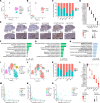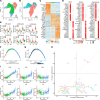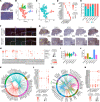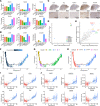Single-cell sequencing reveals Hippo signaling as a driver of fibrosis in hidradenitis suppurativa
- PMID: 38051587
- PMCID: PMC10836805
- DOI: 10.1172/JCI169225
Single-cell sequencing reveals Hippo signaling as a driver of fibrosis in hidradenitis suppurativa
Abstract
Hidradenitis suppurativa (HS) is a chronic inflammatory disease characterized by abscesses, nodules, dissecting/draining tunnels, and extensive fibrosis. Here, we integrate single-cell RNA sequencing, spatial transcriptomics, and immunostaining to provide an unprecedented view of the pathogenesis of chronic HS, characterizing the main cellular players and defining their interactions. We found a striking layering of the chronic HS infiltrate and identified the contribution of 2 fibroblast subtypes (SFRP4+ and CXCL13+) in orchestrating this compartmentalized immune response. We further demonstrated the central role of the Hippo pathway in promoting extensive fibrosis in HS and provided preclinical evidence that the profibrotic fibroblast response in HS can be modulated through inhibition of this pathway. These data provide insights into key aspects of HS pathogenesis with broad therapeutic implications.
Keywords: Cytokines; Dermatology; Fibrosis; Inflammation; Skin.
Conflict of interest statement
Figures








References
MeSH terms
Grants and funding
LinkOut - more resources
Full Text Sources
Medical
Molecular Biology Databases

